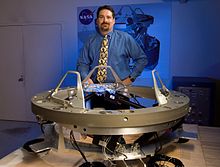Low Impact Docking System
- Low Impact Docking System
-

Low-
Impact Docking System
Das Low Impact Docking System (LIDS) ist ein von der NASA entwickelter Kopplungsmechanismus für Raumfahrzeuge der nächsten Generation, insbesondere für das Project Constellation. Der Mechanismus selbst ist patentiert.[1]
Das System wurde von Monty Carroll, Ray Morales, Thang Le und James Lewis im Rahmen des Advanced Docking Berthing System Project am Johnson Space Center entwickelt. Die Gruppe arbeitete acht Jahre an dem Kopplungsmechanismus für das mittlerweile gestoppte X-38 Crew Return Vehicle.
In Form und Funktion erinnert das LIDS an das APAS-89-System, welches auf der Internationalen Raumstation im Einsatz ist. Es ist aber mit diesem nicht kompatibel. LIDS ist kleiner, leichter und benötigt weniger Kraft um den Kopplungsmechanismus auszulösen als APAS-89. Durch die Inkompatibilität müssten einige der Kopplungsadapter der ISS für das geplante Ankoppeln des neuen Orion-Raumschiffs ausgetauscht werden.
Bigelow Aerospace hat Pläne, die LIDS-Technologie von der NASA zu lizenzieren.[2]
Einzelnachweise
- ↑ Patent US6354540: Androgynous, Reconfigurable Closed Loop Feedback Controlled Low Impact Docking System With Load Sensing Electromagnetic Capture Ring.
- ↑ Federal Register. Abgerufen am 18. Mai 2008.
Quellen
- James L. Lewis; NASA (Hrsg.): Advanced Docking Berthing System. (PDF, abgerufen am 18. Mai 2008).
- James L. Lewis, Monty B. Carroll; NASA (Hrsg.): Prototype Low Impact Docking System. (PDF, abgerufen am 18. Mai 2008).
Wikimedia Foundation.
Schlagen Sie auch in anderen Wörterbüchern nach:
Low Impact Docking System — The Low Impact Docking System (LIDS) is the space vehicle mating system designed by NASA for the next generation of space exploration vehicles included in Project Constellation. The mechanism is covered by Cite patent|US|6354540, titled… … Wikipedia
NASA Docking System — Low Impact Docking System Le NASA Docking System (NDS) ou international Low Impact Docking System (iLIDS) (anciennement Low Impact Docking System LIDS) est un système d amarrage conçu par la NASA pour la nouvelle génération des vaisseaux spatiaux … Wikipédia en Français
NASA Docking System — (Passive on the left, active on the right) … Wikipedia
LIDS — Low Impact Docking System Contributor: GSFC, MSFC … NASA Acronyms
Orion (Constellation program) — For deep space spacecraft based on the Orion design, see Multi Purpose Crew Vehicle. For initial design of the Orion Crew Exploration Vehicle, see Crew Exploration Vehicle. For the nuclear powered spacecraft designed in the 1950s, see Project… … Wikipedia
Système d'amarrage sonde-cône — La sonde russe démontée avec la tête rétractée Un système d amarrage sonde cône est un dispositif d accrochage mécanique des véhicules spatiaux comportant une partie mâle, appelée sonde, portée par le vaisseau manœuvrant et une partie femelle (le … Wikipédia en Français
Ankopplung (Raumfahrt) — Als Ankopplung (engl. Docking) wird in der Raumfahrt die Verbindung zweier Raumschiffe oder Module während eines Weltraum Rendezvous bezeichnet, die sich dazu auf einer fast identischen Bahn befinden müssen. Eine spätere Lösung der Verbindung… … Deutsch Wikipedia
Orion (spacecraft) — Infobox Spacecraft Name = Orion Caption = Orion logo designed by Michael Okuda Organization = NASA Major Contractors = Lockheed Martin Bus = Mission Type = Crew Exploration Vehicle Flyby Of = Satellite Of = Earth, Moon, Asteroid, Mars (possibly)… … Wikipedia
Common Berthing Mechanism — Écoutille de type CBM. À gauche la face interne appartenant à l écoutille du module Harmony. À droite, en position fermée, la face externe de l écoutille du vaisseau cargo HTV. La partie active est côté Harmony … Wikipédia en Français
Bicycle sharing system — Vélo v in Lyon … Wikipedia

